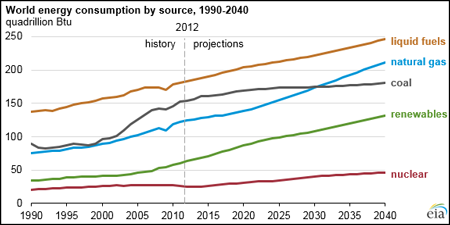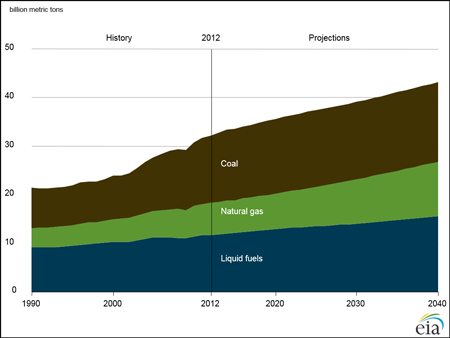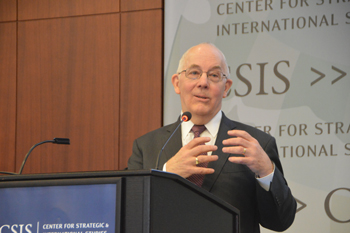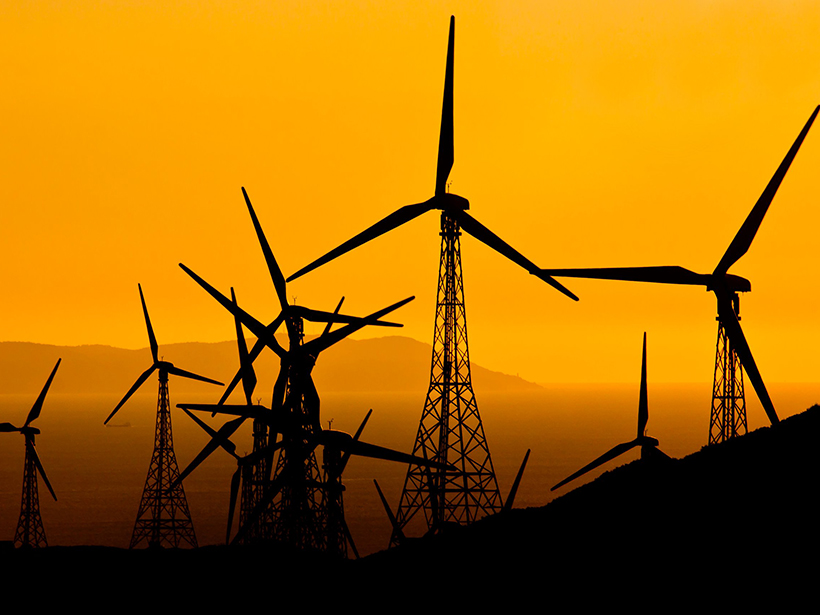
The world’s energy consumption will increase by 48% between 2012 and 2040, with fossil fuels accounting for more than 75% of world energy use in 2040, according to the U.S. Energy Information Administration (EIA). Fossil fuels supplied 83% of global energy demand in 2015.
Energy-related carbon dioxide (CO2) emissions will increase 34% during that time span, with annual emissions rising from 32 billion metric tons in 2012 to 43 billion metric tons in 2040, the agency projects. Coal will continue to generate the most energy-related CO2 emissions worldwide, although its share will decline from 43% in 2012 to 38% in 2040, according to International Energy Outlook 2016 (IEO), a new EIA report released on Wednesday at a briefing in Washington, D. C.
Meeting Climate Targets
The numbers in the report “indicated the challenge for the world to reduce global CO2 emissions substantially by 2040 and beyond,” Jan Mares, senior policy adviser with Resources for the Future, told Eos. The organization is a Washington, D.C.–based think tank focusing on natural resources and environment issues. Other energy and climate analysts said the new projections indicate that the means of energy production need to shift soon if the world is to achieve climate targets.

“The low hanging fruit, which is substituting [natural] gas for coal, seems to be on track and looks pretty robust,” David Goldwyn, president of Goldwyn Global Strategies, an international energy advisory consultancy, told Eos. “But it’s also clear that we need a big technological step change to get to 2 degrees [Celsius] or even frankly to stabilize emissions at the level we have right now. We’re not there yet, and the growth in renewables, which is mostly hydro, is not going to get us there.”
“A business-as-usual scenario, with no new policies beyond those that exist right now, would be disastrous from a climate perspective,” Rachel Cleetus, lead economist and climate policy manager for the Union of Concerned Scientists, told Eos. “The good news is we are not in a business-as-usual world,” she said, citing the recent Paris climate agreement and commitments by major emitters to cut carbon and increase renewables and efficiency.
The new report includes some details from the Paris agreement but notes uncertainty about whether countries will meet their climate targets. EIA head Adam Sieminski said at the briefing that incorporating country climate pledges into the forecast “is complicated” but that the next IEO in 2017 “will probably have more to say” about those commitments.
Renewables on Fast Track
According to the EIA, renewable energy will be the fastest-growing energy source, climbing by 2.6% per year, and nuclear energy will increase from 4% to 6% of the energy pie. Coal, which the report deemed “the world’s slowest-growing energy source,” will rise by about 0.6% per year. In 2040, coal, natural gas, and renewables each will contribute just under 30% of the world’s net electricity generation, the report states.
Cleetus told Eos that the EIA forecast likely underestimates contributions from renewables and energy efficiency and does not address the implications of rising methane emissions associated with natural gas use. The forecast “illustrates the pitfalls of an overreliance on natural gas as we shift away from coal,” she also said.
Asian Energy Consumption Continues Rapid Growth

The outlook forecasts more than half of the energy growth through 2040 coming from China, India, Indonesia, and other developing countries in Asia.
EIA’s Adam Sieminski said at the briefing that some global issues increase the uncertainty of the forecast, including economic growth rates in China and elsewhere, technological innovations, the future of nuclear generating capacity, the implementation and strength of climate policies, and unrest in oil-producing countries.
—Randy Showstack, Staff Writer
Citation: Showstack, R. (2016), High energy growth, fossil fuel dependence forecast through 2040, Eos, 97, doi:10.1029/2016EO052301. Published on 13 May 2016.
Text © 2016. The authors. CC BY-NC-ND 3.0
Except where otherwise noted, images are subject to copyright. Any reuse without express permission from the copyright owner is prohibited.

